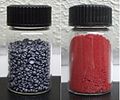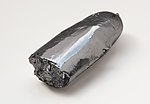Californium dichloride is a binary inorganic compound of californium metal and chlorine with the chemical formula CfCl2. CfCl2 can be prepared by hydrogen...
2 KB (107 words) - 22:44, 11 May 2024
CfF3 Californium(III) iodide – CfI3 Californium(II) iodide – CfI2 Californium(III) nitrate – Cf(NO3)3 Californium(III) oxide – Cf2O3 Californium(III)...
119 KB (8,734 words) - 09:23, 30 July 2024
California, in 1974. They created seaborgium by bombarding atoms of californium-249 with ions of oxygen-18 until seaborgium-263 was produced. During...
18 KB (1,947 words) - 03:07, 16 May 2024
compounds, chlorine gives S(II) and S(I) derivatives. Thus, sulfur dichloride, disulfur dichloride, and higher chlorosulfanes arise from the chlorination of sulfur...
99 KB (11,030 words) - 21:33, 18 August 2024
zirconium dioxide, and organometallic compounds, such as zirconocene dichloride. Five isotopes occur naturally, four of which are stable. The metal and...
47 KB (5,333 words) - 18:54, 17 August 2024
intensively studied. The most common organotitanium complex is titanocene dichloride ((C5H5)2TiCl2). Related compounds include Tebbe's reagent and Petasis...
79 KB (8,788 words) - 08:10, 13 August 2024
silver carbonate 534–16–7 Ag2C2O4 silver oxalate 533–51–7 Ag2Cl2 disilver dichloride 75763–82–5 Ag2CrO4 silver chromate 7784–01–2 Ag2Cr2O7 silver dichromate...
139 KB (120 words) - 17:07, 15 July 2024
chloride and is structurally analogous to disulfur dichloride. Metastable solutions of selenium dichloride can be prepared from sulfuryl chloride and selenium...
95 KB (11,044 words) - 22:05, 13 August 2024
tetrachlorides are precursors to various organohafnium compounds such as hafnocene dichloride and tetrabenzylhafnium. The white hafnium oxide (HfO2), with a melting...
46 KB (5,394 words) - 10:16, 17 July 2024
as TmCl3·7H2O and Tm2(C2O4)3·6H2O are green or greenish-white. Thulium dichloride reacts very vigorously with water. This reaction results in hydrogen gas...
28 KB (3,250 words) - 02:38, 16 August 2024
xenon fluorides are well characterized, the other halides are not. Xenon dichloride, formed by the high-frequency irradiation of a mixture of xenon, fluorine...
110 KB (12,014 words) - 20:36, 12 August 2024
chlorine produced is used to make poly(vinyl chloride) through ethylene dichloride and vinyl chloride. The chlorine produced is available in cylinders from...
117 KB (13,028 words) - 12:00, 13 August 2024
reagent used to generate the organometallic compounds, such as niobocene dichloride ((C 5H 5) 2NbCl 2). The tetrahalides (NbX 4) are dark-coloured polymers...
83 KB (8,180 words) - 16:04, 18 August 2024
halides exist in anhydrous and hydrated forms. Whereas the anhydrous dichloride is blue, the hydrate is red. The reduction potential for the reaction...
96 KB (10,294 words) - 12:45, 13 August 2024
Typical tin compounds are carboxylic acid derivatives of dibutyltin dichloride, such as dibutyltin dilaurate. Some organotin compounds are relatively...
80 KB (8,900 words) - 03:06, 19 August 2024
400 °C, and triiodide is black. Of the dihalides, difluoride is not known, dichloride is brown, dibromide is black, and diiodide is blue. The only known oxyhalide...
50 KB (5,761 words) - 00:38, 16 August 2024
reagent used to generate the organometallic compounds, such as niobocene dichloride ((C 5H 5) 2NbCl 2). The tetrahalides (NbX 4) are dark-coloured polymers...
80 KB (8,537 words) - 02:13, 19 June 2024
Protactinium Uranium Neptunium Plutonium Americium Curium Berkelium Californium Einsteinium Fermium Mendelevium Nobelium Lawrencium Rutherfordium Dubnium...
107 KB (10,281 words) - 06:05, 4 August 2024
reaction of the bis(NHC)silver(I) complex with bis(acetonitrile)palladium dichloride or chlorido(dimethyl sulfide)gold(I): Silver forms alloys with most other...
94 KB (11,248 words) - 11:22, 15 August 2024
common reagent for the oxidation of alcohols to aldehydes, and iodobenzene dichloride (PhICl2), used for the selective chlorination of alkenes and alkynes....
106 KB (11,790 words) - 10:37, 13 August 2024
PhCN, PPh3, NH3, etc) The complex bis(triphenylphosphine)palladium(II) dichloride is a useful catalyst. Palladium forms a range of zerovalent complexes...
59 KB (6,283 words) - 17:25, 19 August 2024
Baybarz, R. D. (1973). "The preparation and crystal structures of americium dichloride and dibromide". Journal of Inorganic and Nuclear Chemistry. 35 (2): 483...
76 KB (9,245 words) - 19:49, 16 August 2024
bromides have also been explored. In particular, selenium dichloride and sulfur dichloride can react to form organic selenium compounds. Dichalcogen dihalides...
75 KB (8,271 words) - 18:54, 15 August 2024
Actinide Dioxide Cations: Extending Chemistry to Pentavalent Berkelium and Californium". Chemistry - A European Journal. 23 (68): 17369–17378. doi:10.1002/chem...
45 KB (14,032 words) - 09:45, 12 August 2024
The organometallic chemistry of vanadium is well–developed. Vanadocene dichloride is a versatile starting reagent and has applications in organic chemistry...
75 KB (8,481 words) - 18:56, 4 August 2024
and organometallic compounds such as zirconium dioxide and zirconocene dichloride, respectively. Five isotopes occur naturally, three of which are stable...
42 KB (4,989 words) - 03:33, 15 April 2024


















